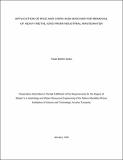Application of rice and corn husk biochar for removal of heavy metal ions from industrial wastewater
Abstract
This study investigated the removal of heavy metal ions from industrial wastewater by using rice
and corn husk biochar. The choice of the materials was influenced by their largest surface area,
plentiful functional groups and their availability in the local environment. Rice and corn husks
were pyrolysed at 500, 600, and 700 °C to make biochars that were used to treat low quality
industrial wastewater. Carbonisation of rice husks at 600 °C produced the best removal efficiencies
for Cr (65%), Fe (90%) and Pb (> 90%). The carbonisation of corn husks at 600 °C produced the
worst removal efficiencies for Cr (only 20%) and Pb (slightly > 35%). Regardless of the
carbonisation temperature, rice husk biochars performed better than corn husk biochars. All data
fitted well in both the Langmuir and Freundlich isotherm models (R
2
values ranging between 0.82
and 0.99). The Langmuir separation factor RL was had negative values; probably due to the low
initial concentration of the adsorbates in the raw wastewater. All the biochars showed a relatively
short contact time (20 to 30 min) to attain maximum adsorption efficiencies – a promising feature
for future industrial applications. The studied biochar materials from rice and corn husk have the
potential to remove heavy metal ions from industrial wastewater; rice husk biochar showed higher
removal capacity than corn husk.
Collections
The following license files are associated with this item:


